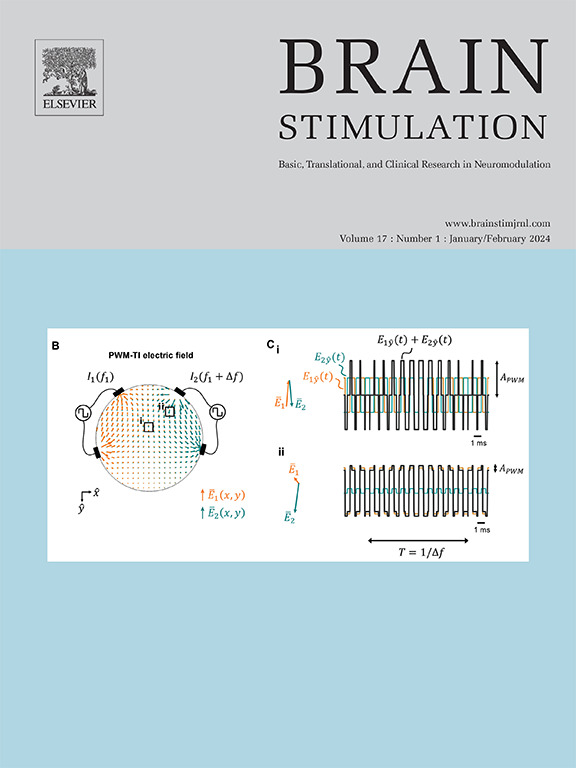Low intensity rTMS in adolescent mice affects visuomotor behaviour with no impact on visual topography
IF 8.4
1区 医学
Q1 CLINICAL NEUROLOGY
引用次数: 0
Abstract
Background
Repetitive transcranial magnetic stimulation (rTMS) is a non-invasive brain stimulation technique used as a therapeutic and experimental tool. It is FDA-approved for treating major depressive disorder in adults and has an excellent safety profile. rTMS is less well characterised in children but was recently approved as an augmentative treatment in adolescents (15–21 years). However, the adolescent brain is still undergoing structural and functional changes and the effect of rTMS on neurodevelopment is not understood.
Objective
In the present study we used a mouse model to assess the impact of low intensity (perifocal) rTMS (LI-rTMS) in the developing brain on visual system organisation and associated behavioural outcomes.
Methods
We used miniature coils to deliver LI-rTMS to the primary visual cortex (V1) in mice aged 28 days (∼12 human years), every day for two weeks (biomimetic high frequency stimulation, 10 min). We measured anatomical organisation of the corticocollicular and geniculocortical visual pathways, visuomotor behaviour, as well as V1 expression of markers of inhibition, excitation and inflammation (astrocytes and microglia) in LI-rTMS and sham treated groups.
Results
LI-rTMS did not alter the organisation of visual pathways, excitatory/inhibitory balance or cause overt inflammation in the brain but did result in a mild deficit in visuomotor behaviour. Our results suggest that LI-rTMS delivered during development may have network-wide effects impacting sensorimotor integration.
Conclusion
While we cannot rule out that changes in functional connectivity might be transient and/or beneficial in a disease context, our findings highlight that more clinical and preclinical studies are needed to validate the safety and mechanism of action of rTMS for children and adolescents.
低强度rTMS对青春期小鼠的视觉运动行为有影响,但对视觉地形无影响
重复经颅磁刺激(rTMS)是一种非侵入性脑刺激技术,被用作治疗和实验工具。它是fda批准的用于治疗成人重度抑郁症的药物,并且具有良好的安全性。rTMS在儿童中不太明显,但最近被批准作为青少年(15-21岁)的辅助治疗。然而,青少年大脑仍在经历结构和功能的变化,rTMS对神经发育的影响尚不清楚。目的在本研究中,我们使用小鼠模型来评估低强度(焦周)rTMS (LI-rTMS)对发育中的大脑视觉系统组织和相关行为结果的影响。方法我们使用微型线圈将LI-rTMS输送到28天(~ 12人年)小鼠初级视觉皮层(V1),每天2周(仿生高频刺激,10分钟)。我们测量了LI-rTMS组和假手术组的皮质- collar和geniculocal视觉通路的解剖组织、视觉运动行为,以及抑制、兴奋和炎症标志物(星形胶质细胞和小胶质细胞)的V1表达。结果i - rtms不会改变视觉通路的组织、兴奋/抑制平衡或引起明显的大脑炎症,但会导致视觉运动行为的轻度缺陷。我们的研究结果表明,在开发过程中提供的LI-rTMS可能具有影响感觉运动整合的全网络效应。虽然我们不能排除功能连接的改变在疾病背景下可能是短暂的和/或有益的,但我们的研究结果强调,需要更多的临床和临床前研究来验证rTMS对儿童和青少年的安全性和作用机制。
本文章由计算机程序翻译,如有差异,请以英文原文为准。
求助全文
约1分钟内获得全文
求助全文
来源期刊

Brain Stimulation
医学-临床神经学
CiteScore
13.10
自引率
9.10%
发文量
256
审稿时长
72 days
期刊介绍:
Brain Stimulation publishes on the entire field of brain stimulation, including noninvasive and invasive techniques and technologies that alter brain function through the use of electrical, magnetic, radiowave, or focally targeted pharmacologic stimulation.
Brain Stimulation aims to be the premier journal for publication of original research in the field of neuromodulation. The journal includes: a) Original articles; b) Short Communications; c) Invited and original reviews; d) Technology and methodological perspectives (reviews of new devices, description of new methods, etc.); and e) Letters to the Editor. Special issues of the journal will be considered based on scientific merit.
 求助内容:
求助内容: 应助结果提醒方式:
应助结果提醒方式:


